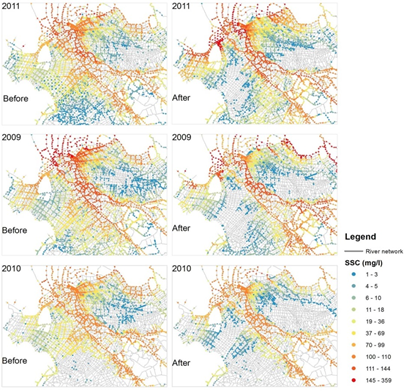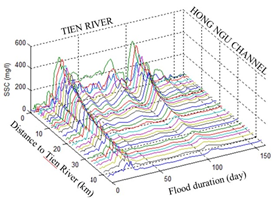Large scale modelling of sediment dynamics
This study focus on the suspended sediment dynamics and sediment-nutrient deposition in the whole Mekong Delta (MD), by apply quasi-2D hydrodynamic model combined with a measurement campaign on sediment-nutrient deposition in floodplains in Vietnam. Floodplains are described as quasi-2D flood cells connected to channels by control structures, ring dike systems are illustrated in the level of gates in control structures. The simulations reveal the general views on sediment transport and sediment distribution in the whole MD and consist of 3 recent representative flood events: extreme high flood, extreme small flood and average flood. Tonle Sap Lake and Cambodian floodplains take an important role into flooding sediment regimes in Vietnamese floodplains. Most of the sediment transport is in the main rivers, 57% - 68% sediment is transported to the Vietnamese Mekong Delta (VMD) at Tan Chau and Chau Doc, 48% - 57% sediment is transported to coastal zones at Can Tho and My Thuan. The higher proportion of sediment can transport to the lower MD in smaller flood event, and higher sediment deposition rate in floodplains is caused by higher flood magnitudes. 11.5% - 15% of the sediment is transported to floodplains in Vietnam and only 1.0% - 6.3% of the sediment is trapped in floodplain compartments.
Figure 1 shows very high spatial variability of suspended sediment concentration (SSC) in floodplains caused by the interactions of two main flow directions, tide influences and the operation of floodplain sluice gates. Table 1 indicates sediment and nutrient deposition rates.

Figure 1: The suspended sediment concentration (SSC) distributions in three typical events in VMD: the left is SSC distribution before sluice gates opening, the right is the SSC distribution after sluice gate opening.
The SSC is reduced along the channel from Tien River to center of PoR (figure 2), the reduction is rapidly when the flood enters the floodplain compartments.

Figure 2: Typical SSC reduction in in the channels with distance to the main river in the Plain of Reeds (PoR) exemplary show for the Hong Ngu channel in 2011.
Table 1: Sedimentation and nutrient deposition rates, and deposition depths of the Vietnamese Mekong Delta.

Table 2 shows the comparisons of deposited nutrients in low ring dike with the nutrient need to apply for a rice crop. Flooding could provide more than 100% potassium in all events, 13% - 75% nitrogen and 10% - 28% phosphorus.
Table 2: The mean nutrient supply from flood events to floodplains and nutrient need for a rice crop in wet season.

Author: Nguyen Van Manh, Nguyen Viet Dung, Nguyen Nghia Hung and Heiko Apel (GFZ German Research Center for Geosciences, Section Hydrology).




